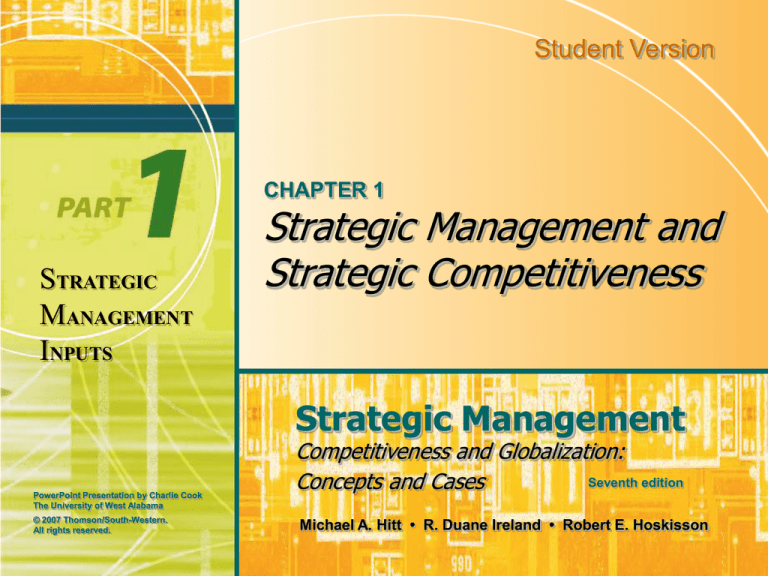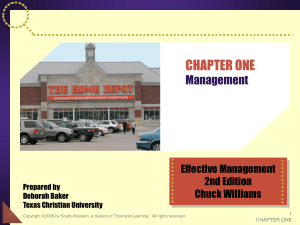
Student Version
CHAPTER 1
STRATEGIC
MANAGEMENT
INPUTS
Strategic Management and
Strategic Competitiveness
Strategic Management
PowerPoint Presentation by Charlie Cook
The University of West Alabama
© 2007 Thomson/South-Western.
All rights reserved.
Competitiveness and Globalization:
Seventh edition
Concepts and Cases
Michael A. Hitt • R. Duane Ireland • Robert E. Hoskisson
Important Definitions
• Strategic Competitiveness
– When a firm successfully formulates and implements
a value-creating strategy.
• Strategy
– An integrated and coordinated set of commitments
and actions designed to exploit core competencies
and gain a competitive advantage.
• Competitive Advantage
– When a firm implements a strategy that its
competitors are unable to duplicate or find too costly
to try to imitate.
© 2007 Thomson/South-Western. All rights reserved.
1–2
Important Definitions (cont’d)
• Risk
– An investor’s uncertainty about the economic gains
or losses that will result from a particular
investment.
• Average Returns
– Returns equal to those an investor expects to earn
from other investments with a similar amount of risk.
• Above-average Returns
– Returns in excess of what an investor expects to
earn from other investments with a similar amount
of risk.
© 2007 Thomson/South-Western. All rights reserved.
1–3
Important Definitions (cont’d)
• Strategic Management Process
– The full set of commitments, decisions, and actions
required for a firm to achieve strategic
competitiveness and earn above-average returns.
© 2007 Thomson/South-Western. All rights reserved.
1–4
The 21st-Century Competitive Landscape
• A Perilous Business World
– Rapid changes in industry boundaries and markets
– Conventional sources of competitive advantage losing
effectiveness
– Enormous investments required to compete globally
– Severe consequences for failure
• Developing and Implementing Strategy
– Allows for planned actions rather than reactions
– Helps coordinate business unit strategies
© 2007 Thomson/South-Western. All rights reserved.
1–5
Global Economy
• The Global Economy
– Goods, people, skills, and ideas move freely across
geographic borders.
– Movement is relatively unfettered by artificial
constraints.
– Expansion into global arena complicates a firm’s
competitive environment.
• Short-term: Where is the fastest growth likely to occur?
• Long-term: Where will sustainable growth occur?
© 2007 Thomson/South-Western. All rights reserved.
1–6
Global Economy (cont’d)
• The March of Globalization
– Increased economic interdependence among
countries—the flow of goods and services, financial
capital, and knowledge across country borders
• Higher performance levels—quality, cost, productivity,
product introduction time, and operational efficiency
– Increased range of opportunities for companies
competing in the 21st-century competitive landscape
• Liability of foreignness—the risks of participating outside of a
firm’s domestic country in the global economy
• The amount of time required for firms to learn how to
compete in markets that are new to them.
© 2007 Thomson/South-Western. All rights reserved.
1–7
Technology and Technological Changes
• Technology Diffusion
– The speed at which new technologies become
available
• Disruptive Technologies
– Technologies that destroy the value of existing
technology and create new markets
• Perpetual Innovation
– The rapidity and consistency with which new,
information-intensive technologies replace older ones
© 2007 Thomson/South-Western. All rights reserved.
1–8
Technological Changes
• The Information Age
– The ability to effectively and efficiently access and
use information has become an important source of
competitive advantage.
– Technology includes personal computers, cellular
phones, artificial intelligence, virtual reality, massive
databases, electronic networks, internet trade.
© 2007 Thomson/South-Western. All rights reserved.
1–9
Technological Changes (cont’d)
• Increasing Knowledge Intensity
– Knowledge as a critical organizational resource for
creating an intangible competitive advantage
– Strategic flexibility: the set of capabilities used to
respond to various demands and opportunities in
dynamic and uncertain competitive environments
– Organizational slack: slack resources that allow the
firm flexibility to respond to environmental changes
– Organizational capacity to learn
© 2007 Thomson/South-Western. All rights reserved.
1–10
I/O Model of Above-Average Returns
• Dominance of the External Environment
– The industry in which a firm competes has a stronger
influence on the firm’s performance than do the
choices managers make inside their organizations.
• Industry Properties Determining Performance
–
–
–
–
–
Economies of scale
Barriers to market entry
Diversification
Product differentiation
Degree of concentration of firms in the industry
© 2007 Thomson/South-Western. All rights reserved.
1–11
Five Forces Model of Competition
• Industry Profitability
– The industry’s rate of return on invested capital
relative to its cost of capital
• An industry’s profitability results from interaction
among:
– Suppliers
– Buyers
– Competitive rivalry among firms currently in the
industry
– Product substitutes
– Potential entrants to the industry
© 2007 Thomson/South-Western. All rights reserved.
1–12
The Resource-Based Model of AboveAverage Returns
• Model Assumptions
– Each organization is a collection of unique resources
and capabilities that provides the basis for its strategy
and that is the primary source of its returns.
– Capabilities evolve and must be managed
dynamically.
– Differences in firms’ performances are due primarily
to their unique resources and capabilities rather than
structural characteristics of the industry.
– Firms acquire different resources and develop unique
capabilities.
© 2007 Thomson/South-Western. All rights reserved.
1–13
Criteria for Resources and Capabilities That
Become Core Competencies
Valuable
Rare
Core
Competencies
Nonsubstitutable
© 2007 Thomson/South-Western. All rights reserved.
Costly to Imitate
1–14
Vision and Mission
• Vision
– A enduring picture of what the firm wants to be and, in
broad terms, what it wants to ultimately achieve.
• Stretches and challenges people and evokes
emotions and dreams.
• Effective vision statements are:
– Developed by a host of people from across the
organization.
– Clearly tied to external and internal environmental
conditions.
– Consistent with strategic leaders’ decisions and
actions.
© 2007 Thomson/South-Western. All rights reserved.
1–15
Vision and Mission (cont’d)
• Mission
– Specifies the business or businesses in which the firm
intends to compete and the customers it intends to
serve.
– Is more concrete than the firm’s vision.
– Is more effective when it fosters strong ethical
standards.
• Above-average returns are the fruits of the firm’s
efforts to achieve its vision and mission.
© 2007 Thomson/South-Western. All rights reserved.
1–16
Stakeholders
• Individuals and groups who can affect, and are
affected by, the strategic outcomes achieved and
who have enforceable claims on a firm’s
performance.
– Claims on the firm’s performance are enforced by the
stakeholder’s ability to withhold participation essential
to the firm’s survival.
– The more critical and valued a stakeholder’s
participation, the greater a firm’s dependency on it.
– Managers must find ways to either accommodate or
insulate the organization from the demands of
stakeholders controlling critical resources.
© 2007 Thomson/South-Western. All rights reserved.
1–17
Strategic Leaders
• Strategic Leaders
– People located in different parts of the firm who are
using the strategic management process to help the
firm reach its vision and mission.
• Prerequisites for Effective Strategic Leadership
–
–
–
–
–
Hard work
Thorough analyses
Honesty
Desire for accomplishment
Common sense
© 2007 Thomson/South-Western. All rights reserved.
1–18
Strategic Leaders (cont’d)
• Organizational Culture
– The complex set of ideologies, symbols, and core
values that are shared throughout the firm and that
influence how the firm conducts business.
• The Value of a Functional Organizational Culture
– Supports effective delegation of strategic
responsibilities
– Provides support for strategic leaders
– Encourages social energy
– Fosters of respect for others
© 2007 Thomson/South-Western. All rights reserved.
1–19
Predicting Outcomes of Strategic Decisions:
Profit Pools
• Profit Pool
– The total profits earned in an industry at all points
along the value chain
• Identifying the components of a profit pool:
– Define the pool’s boundaries.
– Estimate the pool’s overall size.
– Estimate size of each value-chain activity in the pool.
– Reconcile the calculations—which activity provides
the most profit potential?
© 2007 Thomson/South-Western. All rights reserved.
1–20







